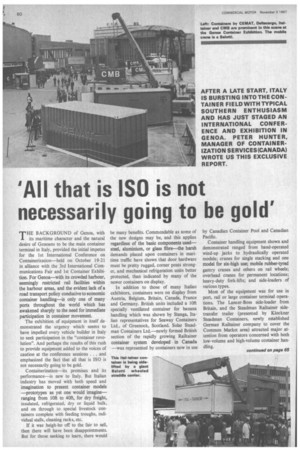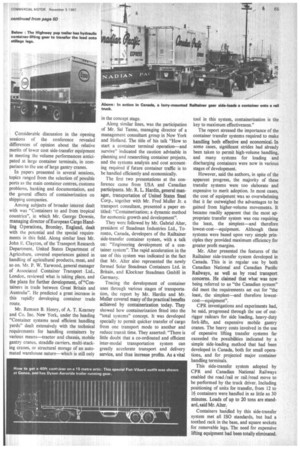'All that is ISO is not necessarily going to be gold'
Page 62

Page 67

If you've noticed an error in this article please click here to report it so we can fix it.
THE BACKGROUND of Genoa, with its maritime character and the natural desire of Genoans to be the main container terminal in Italy, provided the initial impetus for the 1st International Conference on Containerization—held on October 19-21 in alliance with the 3rd International Communications Fair and 1st Container Exhibition. For Genoa—with its crowded harbour, seemingly restricted rail facilities within the harbour areas, and the evident lack of a road transport policy conducive to economic container handling—is only one of many ports throughout the world which has awakened sharply to the need for immediate participation in container movement.
The exhibition of equipment in itself demonstrated the urgency which seems to have impelled every vehicle builder in Italy to seek participation in the "container revolution". And perhaps the results of this rush to provide equipment added to the voices of caution at the conference sessions . . . and emphasized the fact that all that is ISO is not necessarily going to be gold.
Containerization—its promises and its performance—is new to Italy. But Italian industry has moved with both speed and imagination to present container models —prototypes as yet one would imagine— ranging from 10ft to 40ft, for dry freight, insulated, refrigerated, dry or liquid bulk, and on through to special livestock containers complete with feeding troughs, individual stalls, cleaning racks, etc.
If it was heigh-ho off to the fair to sell, then there will have been disappointments. But for those seeking to learn, there would be many benefits. Commendable as some of the new designs may be, and this applies regardless of the basic components used— steel, aluminium, or glass fibre—the harsh demands placed upon containers in maritime traffic have shown that door hardware must be pretty rugged, corner posts stronger, and mechanical refrigeration units better protected, than indicated by many of the newer containers on display.
In addition to those of many Italian exhibitors, containers were on display from Austria, Belgium, Britain, Canada, France and Germany. British units included a 10ft specially ventilated container for banana handling which. was shown by Stanga, Italian representatives for Seaway Containers Ltd., of Greenock, Scotland. Solar Steadman Containers Ltd.—newly formed British section of the rapidly growing Railtainer container system developed in Canada —was represented by containers now in use by Canadian Container Pool and Canadian Pacific.
Container handling equipment shown and demonstrated ranged from hand-operated wind-up jacks to hydraulically operated models; cranes for single stacking and one model for six-high use; mobile rubber-tyred gantry cranes and others on rail wheels; overhead cranes for permanent locations; heavy-duty fork-lifts; and side-loaders of various types.
Most of the equipment was for use in port, rail or large container terminal operations. The Lancer-Boss side-loader from Britain, and the Steadman Railtainer sidetransfer trailer (presented by Klockner Steadman Containers, newly established German Railtainer company to cover the Common Market area) attracted major attention from operators concerned with both low-volume and high-volume container han Considerable discussion in the opening sessions of the conference revealed differences of opinion about the relative merits of lower cost side-transfer equipment in meeting the volume performances anticipated at large container terminals, in comparison to the use of large gantry cranes.
In papers presented in several sessions, topics ranged from the selection of possible ports as the main container centres, customs problems, banking and documentation, and the general effects of containerization on shipping companies.
Among subjects of broader interest dealt with was "Containers to and from tropical countries", in which Mr. George Downie, managing director of European Cargo Handling Operations, Bromley, England, dealt with the potential and the special requiretnents in this field. Along similar lines Mr. John E. Clayton, of the Transport Research Department, United States Department of Agriculture, covered experiences gained in handling of agricultural products, meat, and so on. Mr. P. W. Yarwood, general manager of Associated Container Transport Ltd., London, reviewed what is taking place, and the plans for further development, of "Containers in trade between Great Britain and Australia". He predicted a great increase in this rapidly developing container trade route.
Mr. Remsen B. Henry, of A. T. Kearney and Co. Inc. New York, under the heading "Container systems need efficient handling yards" dealt extensively with the technical requirements for handling containers by various means—tractor and chassis, mobile gantry cranes, straddle carriers, multi-stacking cranes, or structural storage of an automated warehouse nature—which is still only in the concept stage.
Along similar lines, was the participation of Mr. Sal Tanne, managing director of a management consultant group in New York and Holland. The title of his talk "How to start a container terminal operation—and survive" indicated the caution advisable in planning and researching container projects, and the systems analysis and cost accounting required if future container traffic is to be handled efficiently and economically.
The first two presentations at the conference came from USA and Canadian participants. Mr. R. L. Hardin, general manager, transportation of United States Steel Corp., together with Mr. Fred Muller Jr. a transport consultant, presented a paper entitled: "Containerization; a dynamic method for ecobomic growth and development".
They were followed by Mr. Gabriel Alter, president of Steadman Industries Ltd., Toronto, Canada, developers of the Railtainer side-transfer container system, with a talk on: "Engineering development of a container system". The rapid acceleration in the• use of this system was indicated in the fact that Mr. Alter also represented the newly formed Solar Steadman Containers Ltd. in Britain, and Klockner Steadman GmbH in Germany.
Tracing the development of container uses through various stages of transportation, the report by Mr. Hardin and Mr. Muller covered many of the practical benefits achieved by containerization today. They showed how containerization fitted into the "total systems" concept. It was developed specially to permit quicker transfer of cargo from one transport mode to another and reduce transit time. They asserted: "There is little doubt that a co-ordinated and efficient inter-modal transportation system can greatly accelerate transport and delivery service, and thus increase profits. As a vital
tool in this system, containerization is the key to maximum effectiveness."
The report stressed the importance of the container transfer systems required to make handling both effective and economical. In some cases, significant strides had already been taken to permit high-volume handling, and many systems for loading and discharging containers were now in various stages of development.
However, said the authors, in spite of the apparent progress, the majority of these transfer systems were too elaborate and expensive to merit adoption. In most cases, the cost of equipment was so overwhelming that it far outweighed the advantages to be gained from higher-volume movements. It became readily apparent that the most appropriate transfer system was one requiring the least, the simplest—and therefore lowest-cost—equipment. Although these systems were based upon very simple principles they provided maximum efficiency for greater profit margins.
Mr. Alter presented the features of the Railtainer side-transfer system developed in Canada. This is in regular use by both Canadian National and Canadian Pacific Railways, as well as by road transport concerns. He claimed that what was now being referred to as "the Canadian system" did meet the requirements set out for "the least, the simplest—and therefore lowestcost—equipment".
CPR investigations and experiments had, he said, progressed through the use of outrigger railcars for side loading, heavy-duty fork-lifts, and expensive mobile gantry cranes. The heavy costs involved in the use of expensive lifting transfer systems far exceeded the possibilities indicated by a simple side-loading method that had been developed in Canada, both for small operations, and for projected major container handling terminals.
This side-transfer system adopted by CPR and Canadian National Railways enabled the road /rail or rail/road move to be performed by the truck driver. Including positioning of units for transfer, from 12 to 16 containers were handled in as little as 30 minutes. Loads of up to 20 tons are standard, said Mr. Alter: Containers handled by this side-transfer system met all ISO standards, but had a toothed rack in the base, and square sockets for removable legs. The need for expensive lifting equipment had been totally eliminated. dling. continued on page 65








































































































































